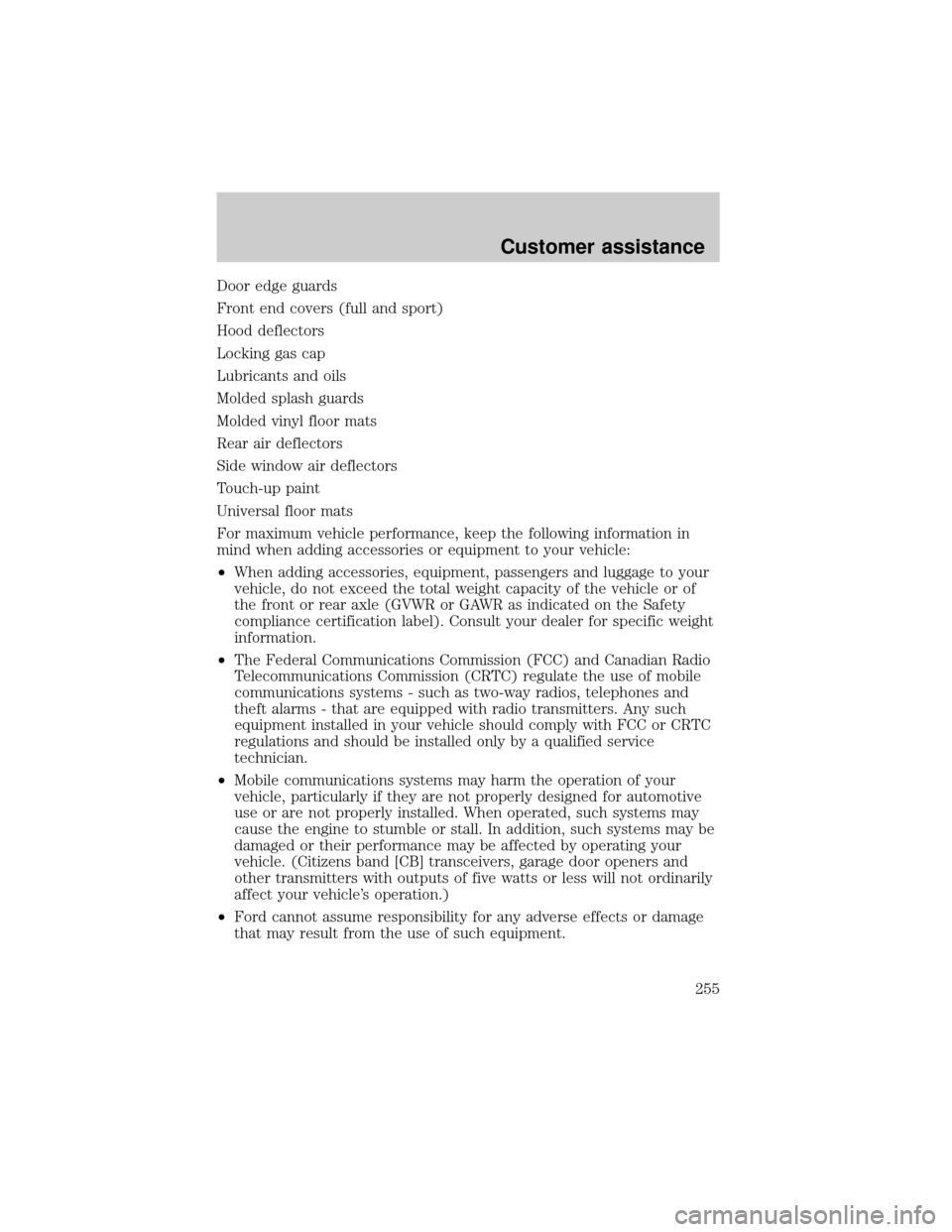window Mercury Mountaineer 2000 s Owner's Guide
[x] Cancel search | Manufacturer: MERCURY, Model Year: 2000, Model line: Mountaineer, Model: Mercury Mountaineer 2000Pages: 264, PDF Size: 2.29 MB
Page 212 of 264

²Always dispose of automotive
batteries in a responsible manner.
Follow your local authorized
standards for disposal. Call your
local authorized recycling center
to find out more about recycling
automotive batteries.
WINDSHIELD WIPER BLADES
Check the wiper blades at least twice a year or when they seem less
effective. Substances such as tree sap and some hot wax treatments used
by commercial car washes reduce the effectiveness of wiper blades.
Checking the wiper blades
If the wiper blades do not wipe properly, clean both the windshield and
wiper blades using undiluted windshield wiper solution or a mild
detergent. Rinse thoroughly with clean water. To avoid damaging the
blades, do not use fuel, kerosene, paint thinner or other solvents.
Changing the wiper blades
To replace the wiper blades:
1. Pull the wiper arm away from the
windshield and lock into the service
position.
2. Turn the blade at an angle from
the wiper arm. Push the lock pin
manually to release the blade and
pull the wiper blade down toward
the windshield to remove it from the
arm.
3. Attach the new wiper to the
wiper arm and press it into place until a click is heard.
REAR WINDOW WIPER BLADES
Refer toWindshield Wiper Bladesin this section for more information
on rear wiper blades.
LEAD
RETURN
RECYCLE
Maintenance and care
212
Page 224 of 264
![Mercury Mountaineer 2000 s Owners Guide Conditions
²Heavily loading a vehicle or towing a trailer may reduce fuel economy
at any speed.
²Carrying unnecessary weight may reduce fuel economy (approximately
0.4 km/L [1 mpg] is lost for every Mercury Mountaineer 2000 s Owners Guide Conditions
²Heavily loading a vehicle or towing a trailer may reduce fuel economy
at any speed.
²Carrying unnecessary weight may reduce fuel economy (approximately
0.4 km/L [1 mpg] is lost for every](/img/33/10997/w960_10997-223.png)
Conditions
²Heavily loading a vehicle or towing a trailer may reduce fuel economy
at any speed.
²Carrying unnecessary weight may reduce fuel economy (approximately
0.4 km/L [1 mpg] is lost for every 180 kg [400 lb] of weight carried).
²Adding certain accessories to your vehicle (for example bug
deflectors, rollbars/light bars, running boards, ski/luggage racks) may
reduce fuel economy.
²Using fuel blended with alcohol may lower fuel economy.
²Fuel economy may decrease with lower temperatures during the first
12±16 km (8±10 miles) of driving.
²Driving on flat terrain offers improved fuel economy as compared to
driving on hilly terrain.
²Transmissions give their best fuel economy when operated in the top
cruise gear and with steady pressure on the gas pedal.
²Four-wheel-drive operation (if equipped) is less fuel efficient than
two-wheel-drive operation.
²Close windows for high speed driving.
EPA window sticker
Every new vehicle should have the EPA window sticker. Contact your
dealer if the window sticker is not supplied with your vehicle. The EPA
window sticker should be your guide for the fuel economy comparisons
with other vehicles.
It is important to note the box in the lower left corner of the window
sticker. These numbers represent the Range of L/100 km (MPG)
expected on the vehicle under optimum conditions. Your fuel economy
may vary depending upon the method of operation and conditions.
EMISSION CONTROL SYSTEM
Your vehicle is equipped with various emission control components and a
catalytic converter which will enable your vehicle to comply with
applicable exhaust emission standards. To make sure that the catalytic
converter and other emission control components continue to work
properly:
²Use only the specified fuel listed.
²Avoid running out of fuel.
Maintenance and care
224
Page 234 of 264

Underbody
Flush the complete underside of vehicle frequently. Keep body drain
holes unplugged. Inspect for road damage.
Cleaning non-painted plastic exterior parts
Use vinyl cleaner for routine cleaning. Clean with a tar remover if
necessary. Do not clean plastic parts with thinners, solvents or
petroleum-based cleaners.
Cleaning the exterior lamps
Wash with the same detergent as the exterior of your vehicle. If
necessary, use a tar remover such as Ford Extra Strength Tar and Road
Oil Remover (B7A-19520±AA).
To avoid scratching the lamps, do not use a dry paper towel, chemical
solvents or abrasive cleaners.
Cleaning the wiper blades, windshield and rear window
If the wiper blades do not wipe properly, clean the wiper blade rubber
element with undiluted windshield washer solution or a mild detergent.
To avoid damaging the blades, do not use fuel, kerosene, paint thinner or
other solvents.
If the wiper still does not wipe properly, this could be caused by
substances on the windshield or rear window such as tree sap and some
hot wax treatments used by commercial car washes. Clean the outside of
the windshield or rear window with a non-abrasive cleaner such as Ford
Ultra-Clear Spray Glass Cleaner, (E4AZ-19C507±AA), available from your
Ford Dealer.Do notuse abrasive cleansers on glass as they may cause
scratches. The windshield or rear window is clean if beads do not form
when you rinse it with water. The windshield, rear window and wiper
blades should be cleaned on a regular basis, and blades or rubber
elements replaced when worn.
Cleaning seats equipped with side air bags
Remove dust and loose dirt with a whisk broom or a vacuum cleaner.
Remove fresh spots immediately. Follow the directions that come with
the cleaner. Do not saturate the seat cover with upholstery cleaner.
Maintenance and care
234
Page 236 of 264

refer to theSafety belt maintenancesection in theSeating and safety
restraintschapter.
Cleaning leather seats (if equipped)
To clean, simply use a soft cloth dampened with water and a mild soap.
Wipe the leather again with a damp cloth to remove soap residue. Dry
with a soft cloth. For tougher soiling concerns, Ford recommends using
the Deluxe Leather Care Kit F8AZ-19G253±AA, which is available from
your Ford Dealer. This mild cleaner and special pad, cleans the leather
and maintains its natural beauty. Follow the instructions on the cleaner
label. Regular cleaning of your leather upholstery helps maintain its
resiliency and color.
Do not use household cleaning products, alcohol solutions,
solvents or cleaners intended for rubber, vinyl or plastics.
Woodtone trim
Wipe stains with a soft cloth and a multi-purpose cleaning solution.
Inside windows
Use Ultra-Clear Spray Glass Cleaner (E4AZ-19C507±AA) for the inside
windows if they become fogged.
Cleaning mirrors
Do not clean your mirrors with a dry cloth or abrasive materials. Use a
soft cloth and mild detergent and water. Be careful when removing ice
from outside mirrors because you may damage the reflective surface.
Maintenance and care
236
Page 255 of 264

Door edge guards
Front end covers (full and sport)
Hood deflectors
Locking gas cap
Lubricants and oils
Molded splash guards
Molded vinyl floor mats
Rear air deflectors
Side window air deflectors
Touch-up paint
Universal floor mats
For maximum vehicle performance, keep the following information in
mind when adding accessories or equipment to your vehicle:
²When adding accessories, equipment, passengers and luggage to your
vehicle, do not exceed the total weight capacity of the vehicle or of
the front or rear axle (GVWR or GAWR as indicated on the Safety
compliance certification label). Consult your dealer for specific weight
information.
²The Federal Communications Commission (FCC) and Canadian Radio
Telecommunications Commission (CRTC) regulate the use of mobile
communications systems - such as two-way radios, telephones and
theft alarms - that are equipped with radio transmitters. Any such
equipment installed in your vehicle should comply with FCC or CRTC
regulations and should be installed only by a qualified service
technician.
²Mobile communications systems may harm the operation of your
vehicle, particularly if they are not properly designed for automotive
use or are not properly installed. When operated, such systems may
cause the engine to stumble or stall. In addition, such systems may be
damaged or their performance may be affected by operating your
vehicle. (Citizens band [CB] transceivers, garage door openers and
other transmitters with outputs of five watts or less will not ordinarily
affect your vehicle's operation.)
²Ford cannot assume responsibility for any adverse effects or damage
that may result from the use of such equipment.
Customer assistance
255
Page 259 of 264

washing ....................................231
waxing .....................................232
wheels ......................................233
windows ..................................236
wiper blades ............................234
woodtone trim ........................236
Climate control (see Air
conditioning or Heating) ............22
Clock ..................................41,51,64
Compass, electronic ....................86
calibration .................................88
set zone adjustment .................87
Console ........................................97
overhead ...............................83,84
rear ............................................98
Controls
power seat ...............................113
steering column ........................82
Coolant
checking and adding ..............200
refill capacities .................204,237
specifications ...................240,242
Cruise control
(see Speed control) ....................77
Customer Assistance ................171
Ford accessories
for your vehicle ......................252
Ford Extended
Service Plan ............................245
Getting assistance outside
the U.S. and Canada ..............251
Getting roadside assistance ...171
Getting the
service you need ....................245
Ordering additional
owner's literature ...................256
The Dispute
Settlement Board ...................248
Utilizing the Mediation/
Arbitration Program ...............251
Daytime running lamps
(see Lamps) ................................21Defrost
rear window ..............................33
Dipstick
automatic
transmission fluid ...................206
engine oil .................................195
Doors
door ajar warning .....................12
lubricant specifications ..........240
Driveline universal joint
and slip yoke .............................209
Driving under special
conditions ...........................158,161
mud .....................157,158,160,161
sand ..................................158,160
snow and ice ......157,159,160,162
through water ...........158,161,165
Emergencies, roadside
jump-starting ..........................185
Emission control system ..........224
Engine ........................................242
check engine/service engine
soon light ....................................8
cleaning ...................................232
coolant .....................................200
idle speed control ...................210
lubrication
specifications ...................240,242
refill capacities ........................237
service points ...................194,195
starting after a collision .........172
Engine block heater .................142
Engine oil ..................................195
checking and adding ..............195
dipstick ....................................195
filter, specifications .........198,237
recommendations ...................198
refill capacities ........................237
specifications ...................240,242
Exhaust fumes ..........................143
Floor mats ...................................99
Fluid capacities .........................237
Index
259
Page 262 of 264

Relays ........................................174
Remote entry system ........101,102
illuminated entry ....................105
locking/unlocking doors .........102
panic alarm .............................102
replacement/additional
transmitters .............................104
replacing the batteries ...........104
Reverse sensing system .............33
Roof rack ...................................170
Safety belts (see Safety
restraints) ......................13,116,117
118,119,120,121
Safety defects, reporting ..........257
Safety restraints .................116,117
118,119,120,121
belt minder .............................122
cleaning the
safety belts .......................125,235
extension assembly ................121
for adults ............117,118,119,120
for children ......................133,134
warning light
and chime ...............10,13,121,122
Safety seats for children ..........135
Seat belts
(see Safety restraints) .............116
Seats ..........................................112
child safety seats ....................135
cleaning ............................234,236
memory seat ...........................103
SecuriLock passive
anti-theft system ................109,110
Servicing your vehicle ..............192
Snowplowing .................................3
Spark plugs,
specifications ......................237,242
Special notice ................................3
ambulance conversions ..............3
utility-type vehicles ....................3
Specification chart,
lubricants ............................240,242Speed control ..............................77
Speedometer ...............................14
Starting your vehicle .........140,142
jump starting ..........................185
Steering wheel
controls ......................................82
tilting .........................................81
Tachometer .................................15
Tilt steering wheel ......................81
Tires .............................180,213,214
changing ....................180,181,182
checking the pressure ............214
replacing ..................................215
rotating ....................................214
snow tires and chains ............216
tire grades ...............................214
treadwear ................................213
Towing ................................165,214
recreational towing .................170
trailer towing ..........................165
wrecker ....................................191
Traction-lok rear axle ...............162
Transfer case
fluid checking .........................209
Transmission .............................148
fluid, checking and adding
(automatic) .............................206
fluid, refill capacities ..............237
lubricant specifications ...240,242
Trip odometer .............................15
Turn signal .............................10,76
Vehicle dimensions ...................242
Vehicle Identification Number
(VIN) ..........................................244
Vehicle loading ..........................162
Ventilating your vehicle ...........143
Warning chimes ...........................13
Warning lights (see Lights) .........8
Washer fluid ..............................200
Water, Driving through .............165
Windows
power .........................................94
Index
262